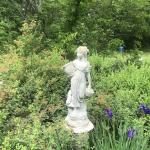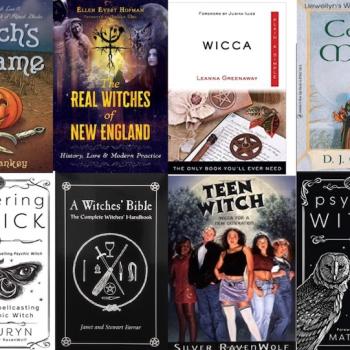The following is an excerpt from Modern Witchcraft With the Greek Gods by Jason Mankey (me) and Astrea Taylor. This might be one of my favorite pieces of writing ever! -Jason
____
Hekate might be the most popular goddess in Modern Witchcraft. Over the last fifteen years, there have been numerous books written by Witches (for Witches) that focus exclusively on her. Hekate is so popular that there are many Witches who refer to themselves as Hekatean Witches, making her the only deity I’m aware of that Modern Witches gravitate toward in such a way.(1) Many Witches are devoted to certain deities, but you don’t see terms like Dionysian Witches or Athenian Witches being used with frequency as identifiers.
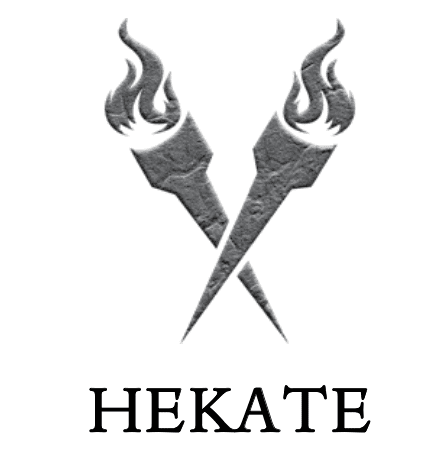
Because so much has been written about Hekate recently, probing her past can be challenging. Scholars of ancient Greek religion and mythology aren’t silent on the subject of Hekate, but they most often write about her as occupying a secondary position in the ancient past.(2) Yet despite the short shrift given to her by some scholars, Hekate is given a large role and accorded a variety of honors and attributes in many influential Greek works from the Classical period.
In Hesiod’s Theogony, Hekate is the daughter of the second-generation Titans Perses and Asteria. When Zeus began his war against the Titans, Hekate had the good sense to side with Zeus and his siblings, and that apparently paid off. According to Hesiod, Hekate’s wisdom resulted in being honored by Zeus “above all others,” and she was given certain privileges. Hesiod wrote that Hekate was given “a share both of the earth and of the undraining sea. From the starry heaven too she has a portion of honor, and she is the most honored by the immortal gods.” (3)
Hesiod then describes the power Hekate has over the earth and its inhabitants, adding that if Hekate likes a follower and finds them sincere, “favor readily attends him…and she grants him prosperity, for she has the power to do so.” (4) Her powers are not limited to providing wealth. She can also stand in judgment, watch over warriors and athletes, increase livestock, and choose who wins and loses battles. (5) Hesiod makes Hekate nearly an equal to Zeus, and he spends more time detailing the powers and attributes of Hekate than those of almost any other deity in Theogony.
The Hekate of Hesiod is also actively involved in human affairs. She listens to those who call to her and rewards (or punishes) them appropriately. Ares loves war for the sake of war, but Hekate protects those who go to war and takes sides in battles. According to Hesiod, Hekate is also in charge of fostering newborns, which gives her a direct link to all of us at birth. (6)
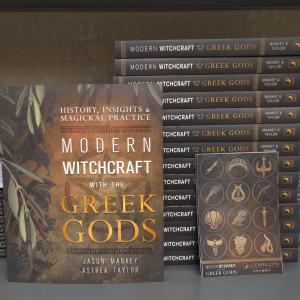
Hesiod’s overt reverence and awe of Hekate might have been the result of his family’s personal devotion to the goddess. (7) Much like there are Hekatean Witches today, Hesiod was most likely a Hekatean Hellenic. An alternative theory suggests that the many lines dedicated to Hekate were added later by someone other than Hesiod. (8) Despite Hesiod’s eloquence, later writers focused on other aspects of Hekate, which are the more familiar aspects of her today: magick, Witchcraft, ghosts, and an association with the dead and the underworld. Hekate was the goddess of the liminal, which is why she was the goddess of the crossroads and transitions. (9) Such attributes make it easy to see why Hekate is so revered today among modern Witches.
Associations with the dead and magick led Hekate to be perceived as a goddess of the night. In art, she’s often pictured with a torch, which would have been necessary for nighttime travel. She carried the torch when searching for Persephone with the goddess Demeter. As a goddess on the move at night, Hekate’s retinue included the spirits of the dead and dogs. (10) Dogs were especially sacred to the goddess, and they were sacrificed to Hekate at her temples. (11) As a goddess of the night, Hekate was also associated with the moon, and she was often syncretized with the moon goddess Selene (and later, the Roman Diana).
The origins of Hekate are difficult to pinpoint. Unlike most of the major deities, she does not seem to appear in the Linear B tablets of the Mycenaean era, and she’s also absent from The Iliad. The earliest reference to Hekate comes from the sixth century BCE in the city of Miletus in southwestern Asia Minor (modern-day Turkey). There, the name Hekate is written on an altar dedicated to Apollo. If this is the birthplace of Hekate, it would make her Anatolian and an import into the pantheon of the Greeks. (12) In her iconography, Hekate is often pictured with lions, a motif that was common among goddesses from the Middle East.(13) An origin in Anatolia would also allow Hekate to absorb a wide range of influences.
Over the centuries. Hekate was equated with a number of different goddesses, including Demeter, Persephone, the previously noted Selene, and most notably Artemis. By the fifth century BCE, images of Artemis and Hekate were nearly identical, and in many places the goddesses had merged completely. Hekate, like Artemis, was generally portrayed as a maiden, with the only distinctions between them being Artemis’s bow and Hekate’s torches. And later, even this distinction began to fade and blur, with Artemis eventually picking up Hekate’s torch. In both inscriptions and literature from the fifth century BCE, there are numerous references to Artemis-Hekate, further blurring the lines between the two goddesses.(14)
In both the ancient world and Modern Witchcraft, Hekate is often syncretized with the goddesses Demeter and Persephone. Like the harvest goddess Demeter, Hekate was also a goddess of abundance and had links to agriculture. But Hekate’s links to Persephone are even more secure. Like Persephone, Hekate was a maiden goddess, and both shared the company of the dead. There were very few deities who might be referred to as Queen of the Dead, and Hekate was one of them. Like Persephone, Hekate often resided in the underworld, and in some myths she was portrayed as an attendant of Persephone (though it’s really hard for me to imagine Hekate in such a secondary role).
Hekate was often depicted in triplicate, most notably with three heads, in a wide range of images. Hekate’s portrayal as a triple goddess most likely evolved out of three masks of Hekate being left at the meeting place of three different roads.(15) This custom evolved into Hekate being identified as a “three-bodied” or “three-formed” goddess.(16) In the Roman world, Hekate went by the name of Trivia, “Goddess of the Three Ways.” (17)
Hekate plays a major role in the story of Persephone’s abduction by Hades. In that tale, Persephone’s abduction is overheard by Hekate, who then leads Demeter to the abode of Helios, where the sun god reveals the location of Persephone. Due to the popularity of the maiden-mother-crone myth of the Great Goddess in many Pagan traditions, the tale of Persephone’s abduction has been used in modern times to argue that Persephone, Demeter, and Hekate are the same goddess. When people erroneously make this argument, Persephone becomes the maiden, Demeter the mother, and Hekate the crone. (18)
This has led to some Modern Witches believing that Hekate is a crone goddess, with an abundance of art and other materials suggesting such a thing. Certainly Hekate is legitimately old, but in the ancient world she was never depicted as a crone or even an older woman. The story of Demeter, Persephone, and Hekate is not a clever allusion to the idea of maiden, mother, and crone in the ancient world.
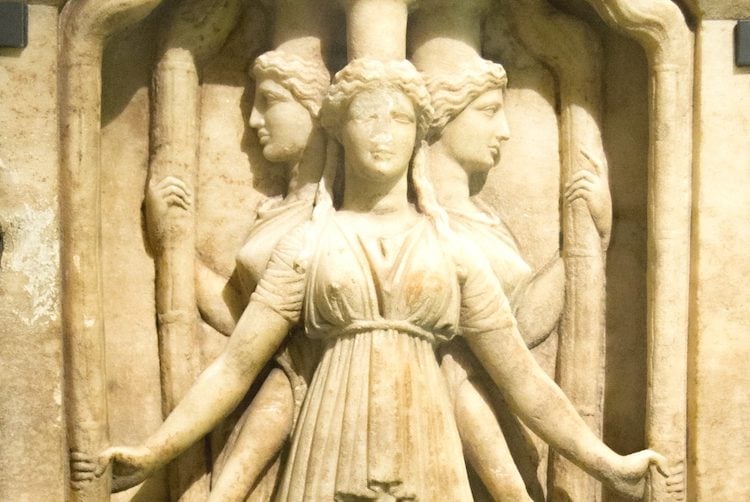
Hekate was most often depicted as a young woman, and an unwed and virgin one at that, though there are exceptions. Because of Hekate’s connection to the realms of the dead, she was a frequent companion of Hermes, who, along with Iris, was the only other god able to move freely between the lands of the living and the dead. The Witches Circe and Medea are sometimes said to be the daughters of Hekate, but these references are just as likely to be symbolic as truly motherly. Since Hekate is a goddess of Witchcraft, it could be argued that any Witch who honors her is her child. Thessaly (or Aeolia in Homer) was well known for its Witches, which made Hekate a frequent visitor to those lands.
Despite the syncretic nature of Hekate in Greek and Roman religion, the goddess always maintained a devoted following of people who honored her as a separate and distinct being. In the Orphic hymns (composed between 0 and 400 CE), Hekate is honored as the first deity sung to. In the Orphic hymn to Hekate, she’s very different from the goddess written about by Hesiod. To the Orphics, Hekate was a goddess of extraordinary power and influence, but also a goddess of the night and the dead. (19) The Orphics also gave her dominion over the earth, sea, and heavens, with the last most likely being an allusion to a realm beyond this one.
Hekate was also a major force in the Chaldean Oracles, a Neoplatonist text popular near the end of the Roman Empire. In the Oracles, Hekate is a mediator between our world and the power that created the universe. Much like in the Orphic hymns, Hekate is given a grand role in the Chaldean Oracles and is called both Savior and the Soul of Nature. (20) During this late Pagan period, Hekate retained her domain over magick and Witchcraft, and her name was invoked in a wide variety of spells.
The name Hekate shows up in both Greco-Roman curse tablets and the Greek Magical Papyri. Curse tablets were used to curse individuals and most often invoked the names of deities associated with the dead. The magick in the papyri was far more variable and included a wide variety of deities and figures from various pantheons (Jewish and Christian figures even make appearances), but no goddess is mentioned more often in those documents than Hekate.(21)
Not surprisingly, mentions of Hekate nearly disappear after the Christianization of the Roman Empire, but the goddess would come roaring back at the end of the European Renaissance. From that period forward, allusions to Witchcraft and magick often included Hekate. In Heinrich Cornelius Agrippa’s (1486–1535) Three Books of Occult Philosophy (published in 1531–1533), the author lists Hekate on a number of occasions, especially when dealing with the spirits of the dead. (22) Grimoires such as Agrippa’s would go on to have a huge influence on modern magickal practices (including Witchcraft), and Hekate’s inclusion in such volumes would serve as an introduction to her for many magickal practitioners.
Hekate’s most celebrated appearances in the early modern period are in the plays of William Shakespeare (1564–1616). (23) Hekate was never a major character in Shakespeare’s plays, but she shows up in Macbeth (1606) as the goddess of the Witches and a keen judge of human character. Shakespeare also wrote often of Hekate being a triple goddess, calling her the “triple Hecate” in A Midsummer Night’s Dream (a reference to the moon), and in Hamlet, Hekate is the goddess of plants and poisons.
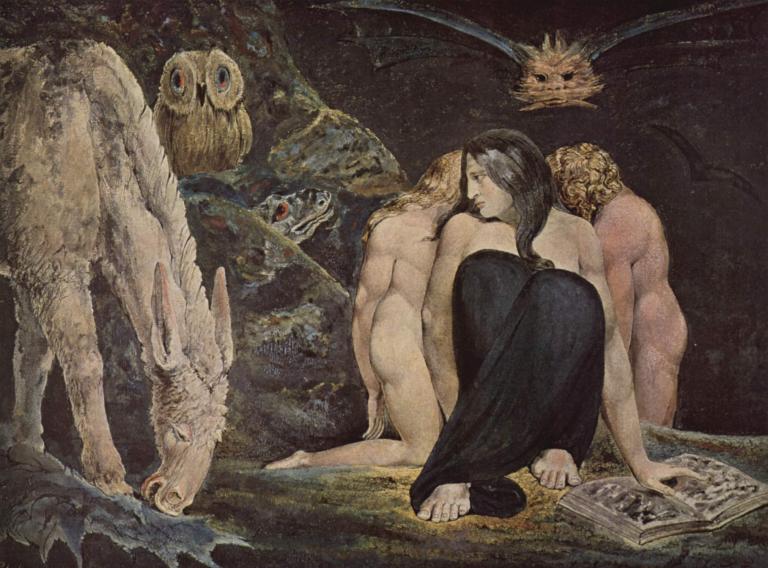
When discussing the Greek gods in the modern era, it’s hard to escape the idea of agency. When a goddess makes herself known, and loudly so, there must be a reason. Hekate as a goddess of Witchcraft and magick speaks to modern Witches like few other deities. With her ability to traverse the realms of both the living and the dead, she’s one of the few deities able to facilitate reunions with those we’ve lost. She’s also empowering, living and doing everything on her own terms. So although the Greek world was highly patriarchal and Zeus held sway over nearly all the gods, even he honored Hekate above all others.
Excerpted from Modern Witchcraft With the Greek Gods: History, Insights & Magickal Practice by Jason Mankey & Astrea Taylor. This excerpt written by Jason Mankey. For sale at well curated Witch-shops, fine booksellers, and online in all the usual places.
NOTES
1. The goddess Diana shows up in the term Dianic Witchcraft, but Dianics are focused on the larger Goddess archetype, not just Diana specifically.
2. In Walter Burkert’s Greek Religion, Hekate is given one exclusive paragraph. The other greater gods all get at least a couple of pages.
3. Hesiod, Theogony & Works and Days, 15.
4. Hesiod, Theogony & Works and Days, 15.
5. Hesiod, Theogony & Works and Days, 16.
6. Lefkowitz, Women in Greek Myth, 22.
7. Burkert, Greek Religion, 171.
8. Lefkowitz, Women in Greek Myth, 20.
9. Giesecke, Classical Mythology A to Z, 58.
10. Burkert, Women in Greek Myth, 171.
11. D’Este, Circle for Hekate, 24.
12. Budin, Artemis, 123.
13. D’Este and Rankine, Hekate: Liminal Rites, 23.
14. Budin, Artemis, 123.
15. Lefowitz, Women in Greek Myth, 171.
16. D’Este, Circle for Hekate, 60.
17. Giesecke, Classical Mythology A to Z, 58.
18. The maiden-mother-crone idea posits that the Great Goddess is represented in triplicate, and the facets represent aspects of a woman’s life. Many people (including the authors of this book) find this idea problematic for a variety of reasons. Because those terms/roles are limiting, some people don’t identify with them. There are many more aspects of life to experience apart from those roles, and not everyone who identifies as a woman follows that trajectory.
19. Dunn, The Orphic Hymns, 41.
20. D’Este, Circle for Hekate, 129.
21. D’Este, Circle for Hekate, 29
22. Agrippa, Three Books of Occult Philosophy, 564, 567.
23. Jason is a committed Oxfordian who believes that Sir Edward de Vere (1550 –1604), the 17th Earl of Oxford, was the true author of the plays attributed to Shakespeare. Sorry for the conspiracy theory– related footnote.
Find Jason Online
My Patreon Starts at Two Bucks!
The Witch’s Book of Spellcraft
The Horned God of the Witches
Transformative Witchcraft: The Greater Mysteries
The Witch’s Wheel of the Year: Circles for Solitaries, Circles, & Covens
Raise the Horns on Facebook Jason’s Twitter
Pictures Of Magickal Stuff
Witch With Books Podcast
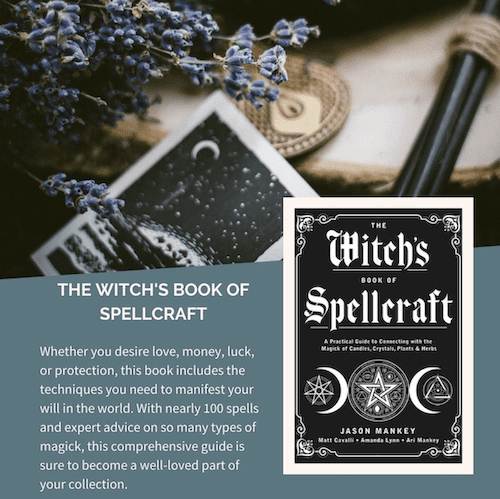
The Horned God of the Witches
Transformative Witchcraft: The Greater Mysteries
The Witch’s Wheel of the Year: Circles for Solitaries, Circles, & Covens
Raise the Horns on Facebook Jason’s Twitter
Pictures Of Magickal Stuff
Witch With Books Podcast

The Witch’s Wheel of the Year: Circles for Solitaries, Circles, & Covens
Raise the Horns on Facebook Jason’s Twitter
Pictures Of Magickal Stuff
Witch With Books Podcast

Pictures Of Magickal Stuff




